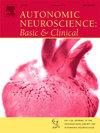Autonomic responses in children and adolescents with orthostatic syncope and presyncope: children are not small adults
IF 3.3
4区 医学
Q2 NEUROSCIENCES
引用次数: 0
Abstract
Children and adolescents commonly experience orthostatic intolerance associated with impaired participation and quality of life. We aimed to characterize autonomic responses to provoked presyncope in children with recurrent presyncope/syncope and healthy adolescents.
We determined orthostatic tolerance (OT, time to presyncope [mins]) in 36 pediatric patients (age 15 ± 3 yrs., 26 female) with recurrent presyncope/syncope, and 17 asymptomatic controls (age 13 ± 3 yrs., 8 female), using a tilt test with graded lower body negative pressure. Cardiovascular parameters, forearm vascular resistance (FVR), mean middle cerebral artery velocity (MCAvmean), and breath-by-breath end tidal gases were continuously monitored. Responses to the Valsalva maneuver (VM), cerebral autoregulation, and cerebral reactivity to carbon dioxide were also determined.
OT was similar in pediatric patients (21 ± 1.5 min) and controls (20 ± 2.0 min, p = 0.74), but smaller than adult reference values (33.8 ± 0.8 min, p < 0.01). Tilting decreased systolic arterial pressure in pediatric patients (p = 0.009), but not pediatric controls (p = 0.12). Tilting decreased MCAvmean (p = 0.002) in pediatric patients, with impairments in cerebral autoregulation (p = 0.02) that were negatively correlated with OT (r = −0.322; p = 0.024). Both pediatric patients (+48.9 ± 8.0 %) and controls (+36.7 ± 14.7 %) had small FVR responses compared to adult reference data (+100 ± 12 %, p < 0.01). Blood pressure responses to the VM were abnormal in pediatric patients, with a lower nadir in mean arterial pressure (81.7 ± 2.0 mmHg) compared to pediatric controls (94.0 ± 2.8 mmHg, p = 0.001).
Pediatric patients with recurrent presyncope/syncope had impaired orthostatic cardiovascular and autoregulatory responses compared to pediatric controls. Sympathetically-mediated responses were small in children, underscoring the need for pediatric-specific standards for orthostatic cardiovascular control, and treatments targeting enhancement of vascular resistance in children with syncope.
儿童和青少年直立性晕厥和晕厥前期的自主神经反应:儿童不是小大人。
儿童和青少年通常经历与参与和生活质量受损相关的直立性不耐受。我们的目的是表征复发性晕厥/晕厥前症儿童和健康青少年对诱发性晕厥前症的自主神经反应。我们测定了36例儿童患者(年龄15±3岁)的直立耐受性(OT,到晕厥前的时间[分钟])。26例女性)伴有复发性晕厥前期/晕厥,对照组17例(年龄13±3岁)。(8名女性),采用倾斜试验,下体负压分级。连续监测心血管参数、前臂血管阻力(FVR)、平均大脑中动脉流速(MCAvmean)和逐呼吸末潮气。对Valsalva动作(VM)的反应、大脑自动调节和大脑对二氧化碳的反应也进行了测定。儿科患者的OT(21±1.5 min)与对照组(20±2.0 min, p = 0.74)相似,但小于成人参考值(33.8±0.8 min, p平均值(p = 0.002),脑自动调节功能障碍(p = 0.02)与OT呈负相关(r = -0.322; p = 0.024)。与成人参考数据相比,儿童患者(+48.9±8.0 %)和对照组(+36.7±14.7%)的FVR反应较小(+100±12%,p
本文章由计算机程序翻译,如有差异,请以英文原文为准。
求助全文
约1分钟内获得全文
求助全文
来源期刊
CiteScore
5.80
自引率
7.40%
发文量
83
审稿时长
66 days
期刊介绍:
This is an international journal with broad coverage of all aspects of the autonomic nervous system in man and animals. The main areas of interest include the innervation of blood vessels and viscera, autonomic ganglia, efferent and afferent autonomic pathways, and autonomic nuclei and pathways in the central nervous system.
The Editors will consider papers that deal with any aspect of the autonomic nervous system, including structure, physiology, pharmacology, biochemistry, development, evolution, ageing, behavioural aspects, integrative role and influence on emotional and physical states of the body. Interdisciplinary studies will be encouraged. Studies dealing with human pathology will be also welcome.

 求助内容:
求助内容: 应助结果提醒方式:
应助结果提醒方式:


